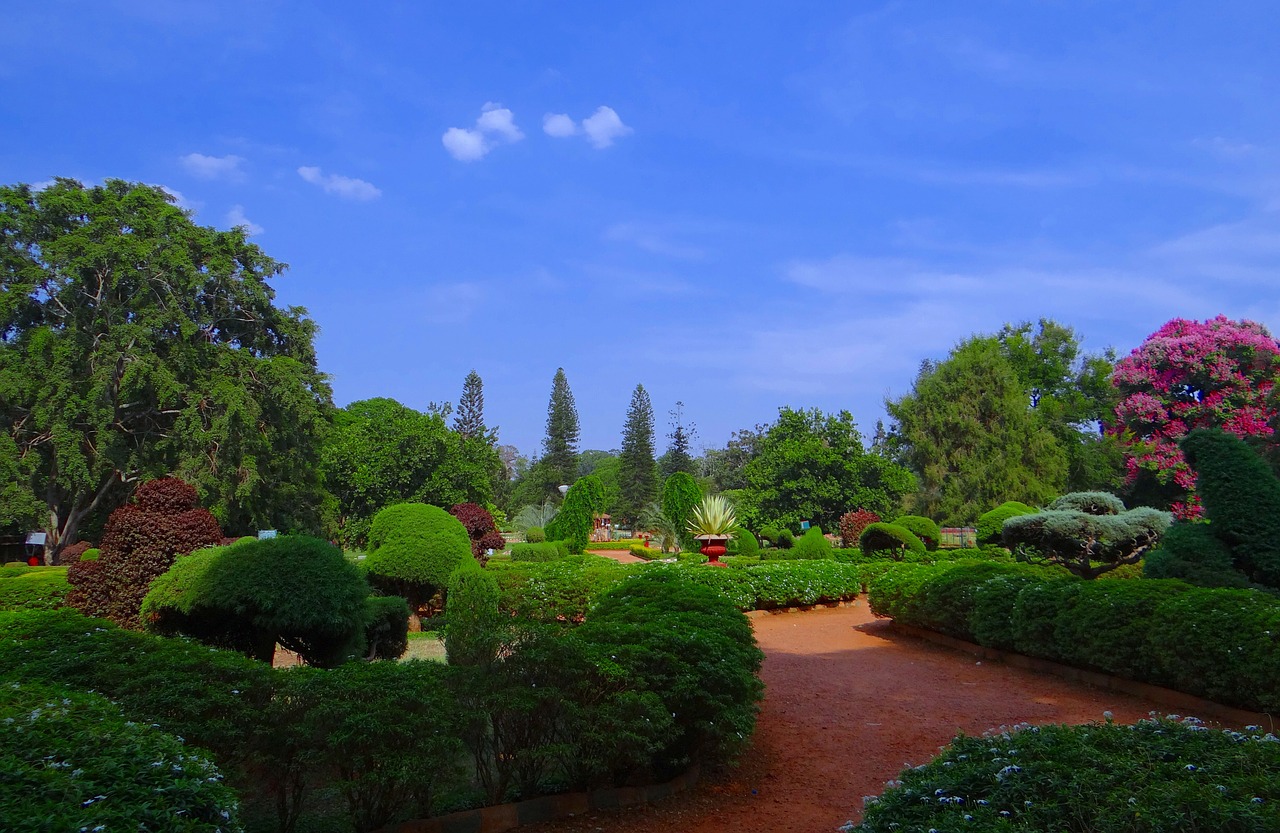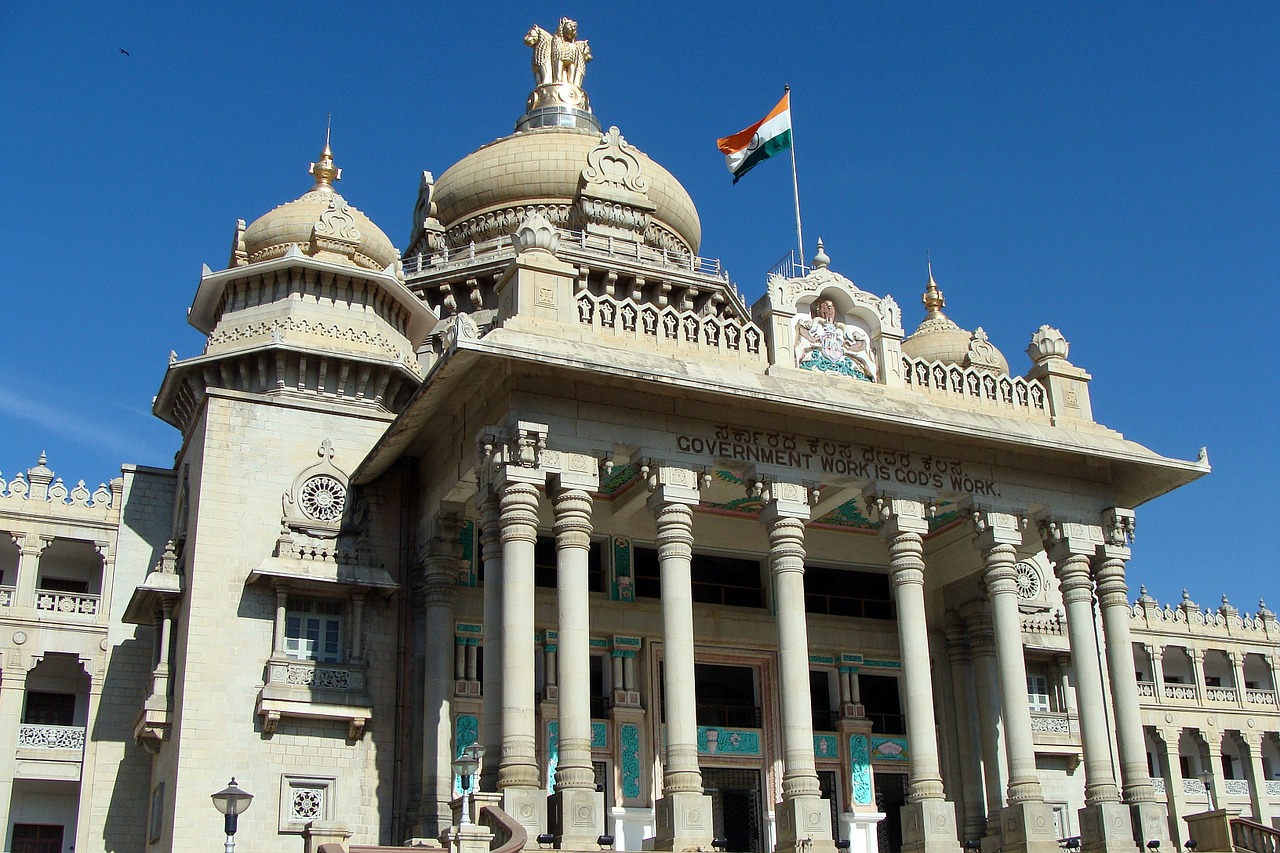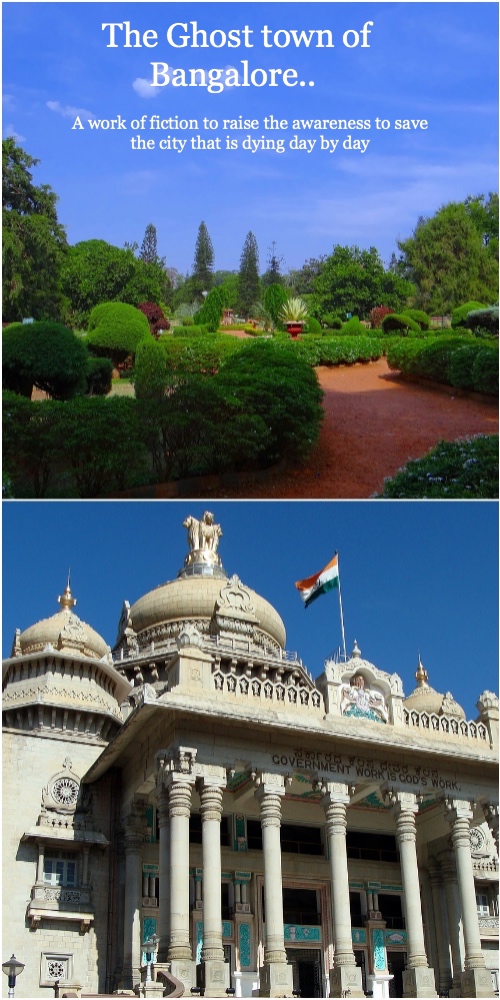2045AD, Today we take you to a tour of the ghost town or dead town called Bangalore or Bengaluru. You will find here ruins of high rise buildings that once thrived with happy families. And also big tech parks which once hosted the most renowned companies of the world. Also, the dead city has remains of several abandoned but beautiful buildings and historical structures of the past era like the Vidhan Saudha, the Tipu Sultan’s palace , The Bangalore Palace etc. to name a few. So, what was this city like in the past? And how it turned into a dead city? Read on to find out.
The Bangalore of the 1980s

In the 1980s and before, Bangalore was a small and charming town. It had lots of green cover and 100s of lakes and beautiful gardens like the Lal Bagh. Moreover, it had a pleasant climate all through the year. Temperature remained moderate. And whenever mercury sore over the moderate range , rain Gods showered their bless over Bangalore immediately, making the evenings and nights particularly pleasant. The town boasted of some of the most beautiful flowering trees in India. In season, when the flowers bloomed, it was difficult to spot even a leaf on the trees. And even the infrastructure was good. With some of the best educational institutes, medical institutes, well maintained roads, abundance of drinking water and all other basic facilities. With pristine climate, natural beauty and very nice people, Bangalore was like the paradise for those who wanted to retire to a peaceful and calm life amidst nature.
We still remember when we first set foot here. How amazed we were at the beauty of this city. And the high quality infrastructure. Plus the fact that it was so centrally located in South India. On weekends, we could pack our bags and explore so many beaches, hill stations, reserve forests and other beautiful places around Bangalore. It was just perfect!!
The Urbanisation of Bangalore
Soon, investors, realtors and the growing software industry saw the potential of Bangalore. Software boom had started in India. And slowly one after the other, companies started opening their centers in Bangalore. They brought lots of jobs with them, drawing the most talented and educated people from across India to Bangalore. As a result, began rapid urbanization of Bangalore. Every year, more and more people started coming here for jobs, making Bangalore their home. The boundaries of the city started expanding in all directions. The growth was so phenomenal that it happened at a pace far beyond anyone’s expectation. Everyone was happy, everyone was in a state of trance. Bangalore soon was fondly labeled the Silicon Valley of India.
The urbanisation saw rapid growth of high rise buildings, flyovers, restaurants, cafes, commercial establishments, office spaces and other such structures all across Bangalore. Everyone was happy seeing new jobs getting generated and rapid urbanisation happening. It is evident the way we living in eastern Bangalore find it comfortable to make trips to Kolar , Avani and even Chennai via Hospete. And dread to cross the traffic through the city to navigate to Mysore highway when we visit places like Mysore, Coorg, Channapatna Toys or Rangnathittu Bird Sanctuary.

The decline of Bangalore
The blind urbanisation of Bangalore
But no one realized in this rush what damage was being done. The space for the new buildings, the rapid urbanization happened at a cost. The cost being massive cutting of trees to create residential and commercial land. In the greed of making fast money, every individual and every organization refused to look back or consider the irreversible damage being done to the environment. Even lakes were filled up. Some dried off. Ground water level started decreasing fast. The growth also saw complete lack of planning due to which all the basic infrastructure started collapsing. There was no proper management for water recycling, garbage dumping, there was no capacity planning for newly developing areas. Air pollution, water pollution, land pollution all sky rocketed.
Followed by the consequences
But still no one paid attention, we are not sure why. People kept talking. Laws were also formed. Committees were also setup. NGOs and voluntary organisations also worked towards reviving the old balance of the city with nature. But the rate of damage was much higher than the rate of damage control. And by this time, a handful of people were not at all enough to battle against the doom that was cast on the city. Every single individual needed to step forward and do his part – from the daily wage earner to the highest possible authorities. But that didn’t happen.
As a result, slowly, the negative effects started showing up. The first decade of 21st century saw a massive decline in the amount of Rain. Humidity level in some months dropped to almost zero. Air pollution increased to intolerable level. People gradually started suffering from respiratory track diseases that just refused to leave them. Children were born with respiratory and allergic diseases. And many developed asthma at a young age. It took hours to commute to work. And that meant being exposed to the vehicle emissions for longer hours. Even lakes started catching fire because of the garbage waste and industrial chemicals dumped into them. All signs that the town was becoming uninhabitable were emerging.
And the ignorance
But we guess everyone refused to let go – let go of their shortsightedness, their ignorance, their lack of awareness. And we continued with the daily lives as if there was no problem at all. It was a part and parcel of life. People went on to adjust with everything and accept everything as a part and parcel of life. The air pollution, the unclean water, the garbage rotting besides their houses – somehow everyone refused to see these as unnatural and unacceptable. Even their own declining health condition seemed all natural to people.
And finally the end
Things got worse year on year, inching us closer to the Ghost town of Bangalore. Not only did the ground water level started falling due to uncontrolled extraction. But slowly it even started getting contaminated. There was no pure drinking water. And the contaminated water was not treated properly. Upon consumption, people started having water born diseases. Many started migrating to other towns and cities. Many lost their hard earned money in costly treatments. And sadly, many succumbed. Those who survived, their lifespan was drastically decreased due to the constant exposure to the deadly pollution of all kinds. Year on year it continued. Finally, there was hardly enough people left to work. And the companies started shutting down.
The whole infrastructure started collapsing. People cried, complained, but no one knew what to do. They finally started running out of Bangalore for their lives. Thus, here it stands today. As a ghost town. When you come to Mysore, or Mandaya or Chennai, do visit this ghost town. It is a live example of what human can bring on himself with blind urbanization and unbound greed. And everyone of us need to learn something from this. From a city which was the pride of India at a point to a dead, ghost town – the story of Bangalore is a lesson for every other city that is on the same path.
Conclusion
PS: This is a work of fiction and written out of our imagination about the Ghost town of Bangalore. But at the same time, it is very much based on the facts that currently represent the state of the city of Bangalore. If things continue at the current rate, we are afraid if the future of Bangalore will be any different from what we narrated here. The motive of this article is not to spread negativity. But rather to spread awareness in the present day, by showing what can happen in the future if the corrective measures are not taken today. We want to save this city from the drastic consequences that it is doomed to face in the near future. And we hope this piece of work will help a little towards achieving the same by arousing some much needed awareness.
We encourage our readers to join hands, and share this article far and wide to help spread the awareness. Lets save one beautiful city on this earth that we all like to visit and so many of us proudly call our home.
PS: Some of our links are affiliated, this means we will earn a commission when you buy a service or product by clicking those links. However, this will have no extra cost for you.

I had fond memories of Bangalore many many years ago. Garden City was stuck to my head and it’s a sad thing to imagine that rapid urbanization will erase this vision of Bangalore and the future generation may not be able to see it. My husband was in the IT field and spent a month in Bangalore for a project so I took the opportunity. It was very short but I definitely would have loved to stay longer having visited the neighboring areas.
You are right Arni. That’s why it pains that much. it is not a natural disaster that is causing the slow death of Bangalore but rather the human themselves. We only are responsible for what is happening. Hope each one of us could understand it while there’s still time at hand to save this beautiful garden city
I was really touched by this. The rate of growth and the rate of damage were not being controlled. Change takes longer than damage. This is remnant of what will happen to America now that Trump has abolished the EPA. I hope people start taking better care of our planet or it won’t be here for long. 🙁
You are right Gina. Hope people see the dire consequences of these blind exploitation of nature and take some action before it is too late
Very journalistic type post! Well researched and presented. I am dreading what if the steel flyover comes though… imagine the damage to the green cover. 🙁
I don’t want that steel flyover thing to happen. And there is immense threat to the western ghats also, some new route getting constructed you know…
This was very sad to read. We humans destroy so many beautiful places in order to make money that is almost criminal. I live and work in the actual Silicon Valley in California, and I know how many companies are currently building huge campuses in India. I hope all the environmental factors as well as the local people are taken into consideration when they do that.
Thank you Paula..do help us share the story in any form possible
Shit! This is one of the most hard hitting posts that I have read in a long time. The Matrix like apocalyptic future is straight out of American movies. Maybe Bangalore can take a leaf out of Delhi’s pollution control and switch to CNG for public transport.
Actually that is much needed Sudipto. But apart from that, other measures are also needed. Although the air pollution in Delhi decreased after CNG and other measures, but still it remains the most polluted city in India as of now with pollution levels at cronic
Wow wasn’t aware about this side of Bangalore. Thanks for sharing 😀
Wow what a powerful work of fiction to raise awareness!
Really interesting, I’ve not read a post in this manner before! Such a unique and interesting way in which to understand an area! Thanks!
Aaaaahhh. I thought the horrible story had an horrible end. I was in Bangalore in 2004 but only for a big layover so I could not appreciate the things you were telling us about.
I wish things turn the other way round for Bangalore !!
I used to read or hear great stories about Bangalore, its rich culture before. I never knew it all came to this. We, humans, should really take good care of our environment and our culture. It’s all we have to share for the future generations. Hoping the government and the rest of the people residing in Bangalore will do some changes for the better of their city.
Hope so Jane. It will be so sad to see such a beautiful city die a slow death because of basic human ignorance
Great post! This can happen anywhere, I really enjoyed the creativity you used to bring awareness to this problem.
Thanks John, hope it reaches out to everyone
Sometimes it is works of fiction such as this that opens up people’s eyes to changes that have to be made. I hope this piece makes a difference and the future is able to correct itself. But you are right in that change must happen sooner than later.
Thanks a lot! I hope this piece makes at least some realize and spring them to action before its too late
good idea and very nice post. I like how you used facts to preview what will happen.
Thanks
Wow what a powerful work of fiction to raise awareness of a very real problem. I like many others thought it was a real account until the end. Hopefully something can be done to prevent the outcome you describe.
Hope so Emma. Truly, we don’t want this story to turn in a reality. It will be heartbreaking and so sad. But as of today, that’s where the city is headed.
Some of my relatives are in Bangalore and had been there since a couple decades. They keep telling me how beautiful Bangalore was and how miserable it has become. One of my cousins say that it isn’t Karnataka anymore, its become a very cosmopolitan city, but the infrastructure doesn’t bear the urbanization its reached!!!
Actually yes. I love the cosmopolitan culture of the city. But the infrastructure is just not ready to take the amount of load that has been put on it in an unplanned way. And as a result, it is slowly crumbling from all perspectives
Bangalore was green and had mild pleasant weather within living memory???
True. Sadly not anymore. Weather is still trying to be it’s best but it has lost it’s capacity in front of the devastation mankind is causing
Seems like a beautiful place to visit. Progress can be a double edge sword.
Not always. But yes, blind and unplanned one
What a very moving and powerful post that contains a strong message and warning for all who live in growing cities. Sincere congratulations on having the foresight and responsibility to spread this very important message for mankind. I hope more and more people heed this warning before it is too late for many of us.
Thanks Nicole. We are really alarmed by what we are seeing in this city. Hope the story in this post remains a story and never comes to be true.
Wow, what a testimony of how ill-treatment of natural resources leads to lower quality of life for humans. Very creative piece that I hope triggers change!
Thanks Dani. Hope things improve
I believe Bangalore still have great things to offer. People in Bangalore should also be helping in restoring the city amidst urbanization. Let’s hope for the best.
Totally agree Jen, lets hope for the best